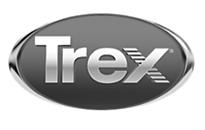Notes to Condensed Consolidated Financial Statements
For the Nine Months Ended September 30, 2019 and 2018
| 1. | BUSINESS AND ORGANIZATION |
Trex Company, Inc. (Company) is the world’s largest manufacturer of wood-alternative decking and railing products, with more than 25 years of product experience, which are marketed under the brand name Trex
®
. The Company manufactures and distributes high-performance,
eco-friendly
wood and plastic composite outdoor living products and related accessories. A majority of its products are manufactured in a proprietary process that combines reclaimed wood fibers and scrap polyethylene. Also, the Company is a leading national provider of custom-engineered railing and staging systems for the commercial and multi-family market, including sports stadiums and performing arts venues. The Company operates in 2 reportable segments, Trex Residential Products (Trex Residential) and Trex Commercial Products (Trex Commercial). The Company is incorporated in Delaware. The principal executive offices are located at 160 Exeter Drive, Winchester, Virginia 22603, and the telephone number at that address is (540)
542-6300.
The accompanying unaudited condensed consolidated financial statements have been prepared in accordance with accounting principles generally accepted in the United States for interim financial information and the instructions to Form
10-Q
and Article 10 of Regulation
S-X
and, accordingly, the accompanying condensed consolidated financial statements do not include all of the information and notes required by accounting principles generally accepted in the United States for complete financial statements. In the opinion of management, all adjustments (consisting of normal and recurring adjustments except as otherwise described herein) considered necessary for a fair presentation have been included in the accompanying condensed consolidated financial statements. The unaudited condensed consolidated financial statements include the accounts of the Company and its wholly-owned subsidiaries, Trex Wood-Polymer Espana, S.L. and Trex Commercial Products, Inc., for all periods presented.
The consolidated results of operations for the three and nine months ended September 30, 2019 are not necessarily indicative of the results that may be expected for the fiscal year ending December 31, 2019. These condensed consolidated financial statements should be read in conjunction with the audited consolidated financial statements as of December 31, 2018 and 2017 and for each of the three years in the period ended December 31, 2018 included in the Annual Report of Trex Company, Inc. on Form
10-K,
as filed with the U.S. Securities and Exchange Commission.
| 3. | RECENTLY ADOPTED ACCOUNTING STANDARDS |
In June 2018, the FASB issued ASU No.
2018-07,
“
Compensation – Stock Compensation (Topic 718)
.” The ASU expands the scope of Topic 718, which currently only includes share-based payments issued to employees, to also include share-based payments issued to nonemployees for goods or services. The ASU supersedes Subtopic
505-50,
“
Equity—Equity-Based Payment to Non-Employees
.” Consequently, the accounting for share-based payments to nonemployees and employees will be substantially aligned. The ASU was effective for fiscal years beginning after December 15, 2018, including interim periods within that fiscal year. The Company adopted the guidance on January 1, 2019. Adoption did not have an impact on the Company’s financial condition or results of operations.
In February 2016, the FASB issued ASU No.
2016-02,
“
” and issued subsequent amendments to the initial guidance in January 2018 within ASU No.
2018-01,
in July 2018 within ASU Nos.
2018-10
and
2018-11,
in December 2018 within ASU No.
2018-20,
and in March 2019 within ASU No.
2019-01
(collectively, the standard). The standard requires lessees to recognize operating leases on the balance sheet as a
right-of-use
asset and a lease liability. The liability is equal to the present value of the lease payments over the remaining lease term. The asset is based on the liability, subject to certain adjustments. Operating leases result in straight-line expense. The Company adopted the standard on January 1, 2019, and elected the transition method of adoption, which allowed the Company to apply the standard as of the beginning of the period of adoption. The Company opted to elect the package of practical expedients to not reassess prior conclusions related to contracts containing leases, lease classification and initial direct costs, and certain other practical expedients, including the use of hindsight to determine the lease term for existing leases and in assessing impairment of the
right-of-use
asset, and the exception for short-term leases. For its current classes of underlying assets, the Company did not elect the practical expedient under which the lease components would not be separated from the nonlease components. Nonlease components include certain maintenance services provided by the lessor and the related consideration is specified on a stand-alone basis in the applicable lease agreements. Adoption of the standard had a significant impact on the Company’s condensed consolidated balance sheet due to the recognition of a
right-of-use
asset and lease liability
(current and
non-current)
of $45.8 million and $47.2 million, respectively, upon adoption. As the Company’s leases do not provide an implicit rate that can be readily determined, the Company used its incremental borrowing rate based on the information available at the implementation date in determining the present value of lease payments.
